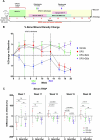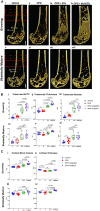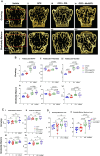Early and multiple doses of zoledronate mitigates rebound bone loss following withdrawal of receptor activator of nuclear factor kappa-B ligand inhibition
- PMID: 39846954
- PMCID: PMC11909728
- DOI: 10.1093/jbmr/zjaf008
Early and multiple doses of zoledronate mitigates rebound bone loss following withdrawal of receptor activator of nuclear factor kappa-B ligand inhibition
Abstract
Rebound bone loss following denosumab discontinuation is an important barrier in the effective long-term treatment of skeletal disorders. This is driven by increased osteoclastic bone resorption following the offset of RANKL inhibition, and sequential osteoclast-directed therapy has been utilized to mitigate this. However, current sequential treatment strategies intervene following the offset of RANKL inhibition and this approach fails to consistently prevent bone loss. Our previous work, using a mouse model of denosumab discontinuation, has shown that the processes that drive the rebound phenomenon occur earlier than when bone loss is detected, namely a rise and overshoot in serum tartrate-resistant acid phosphatase (TRAP). We identified that these changes in serum TRAP may provide an earlier window of opportunity to intervene with sequential therapy following RANKL inhibition withdrawal. Here, we show that early treatment with zoledronate (10 mg/kg, 3 wk following the last dose of OPG:Fc), preceding the rise and overshoot in serum TRAP, effectively mitigates rebound bone density loss through preventing the overshoot in serum TRAP. Further, we show that multiple doses of zoledronate (early treatment and during anticipated BMD loss) is superior in consolidating bone density gains made with RANKL inhibition and preventing rebound BMD loss as measured by DXA. Importantly, we demonstrate the efficacy of early and multi-dose zoledronate strategy in preventing bone loss in both growing and skeletally mature mice. MicroCT analysis showed improved trabecular bone structure in both the femur and lumbar vertebrae with zoledronate treatment compared with control. These increases in bone mass translated to increased fracture resistance in skeletally mature mice. This work provides a novel approach of early and multi-dose sequential treatment strategy following withdrawal of RANKL inhibition, contributing valuable insight into the clinical management of patients who discontinue denosumab therapy.
Keywords: denosumab; denosumab discontinuation; osteoporosis; sequential therapy; zoledronate.
Plain language summary
Stopping denosumab leads to loss of bone gained during treatment, due to increased bone resorption when denosumab wears off. Current strategies often fail to prevent this as they cannot stop osteoclasts resorbing bone. Our work using a mouse model has shown that processes that lead to bone loss start earlier than we can detect in the clinic. We show that early and multi-dose zoledronate treatment, another medication used to block osteoclasts, to target these earlier processes can prevent bone loss after stopping denosumab. This approach offers a new strategy for managing bone health in patients stopping denosumab.
© The Author(s) 2025. Published by Oxford University Press on behalf of the American Society for Bone and Mineral Research.
Conflict of interest statement
M.M.M. has received honoraria for speaking from Amgen Inc.
Figures







Similar articles
-
Temporal patterns of osteoclast formation and activity following withdrawal of RANKL inhibition.J Bone Miner Res. 2024 May 2;39(4):484-497. doi: 10.1093/jbmr/zjae023. J Bone Miner Res. 2024. PMID: 38477789 Free PMC article.
-
Changes in RANKL and TRAcP 5b after discontinuation of denosumab suggest RANKL mediated formation of osteoclasts results in the increased bone resorption.Osteoporos Int. 2023 Mar;34(3):599-605. doi: 10.1007/s00198-022-06651-0. Epub 2022 Dec 22. Osteoporos Int. 2023. PMID: 36543965 Clinical Trial.
-
Mouse model of anti-RANKL discontinuation reveals reduced bone mass and quality through disruption of bone remodeling.Bone Res. 2025 May 28;13(1):56. doi: 10.1038/s41413-025-00433-0. Bone Res. 2025. PMID: 40425548 Free PMC article.
-
Osteoclast Recycling and the Rebound Phenomenon Following Denosumab Discontinuation.Curr Osteoporos Rep. 2022 Dec;20(6):505-515. doi: 10.1007/s11914-022-00756-5. Epub 2022 Oct 6. Curr Osteoporos Rep. 2022. PMID: 36201122 Free PMC article. Review.
-
Denosumab: RANKL inhibition in the management of bone loss.Drugs Today (Barc). 2008 Jan;44(1):7-21. doi: 10.1358/dot.2008.44.1.1178467. Drugs Today (Barc). 2008. PMID: 18301800 Review.
Cited by
-
Denosumab discontinuation in the clinic: implications of rebound bone turnover and emerging strategies to prevent bone loss and fractures.J Bone Miner Res. 2025 Aug 24;40(9):1017-1034. doi: 10.1093/jbmr/zjaf037. J Bone Miner Res. 2025. PMID: 40057981 Free PMC article. Review.
References
MeSH terms
Substances
Grants and funding
- UNSW Sydney University Postgraduate Award
- Australian Government Research Training Program Scholarship
- Australia and New Zealand Bone and Mineral Society and the Endocrine Society of Australia
- R20-05/Ernest Heine Family Foundation and Cancer Council
- American Society of Bone and Mineral Research Rising Star
LinkOut - more resources
Full Text Sources

